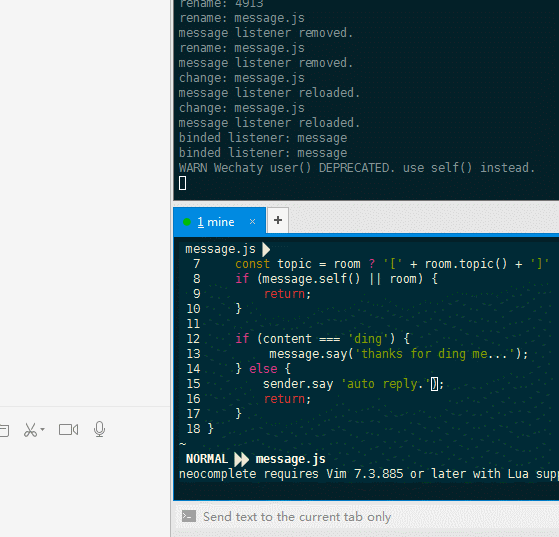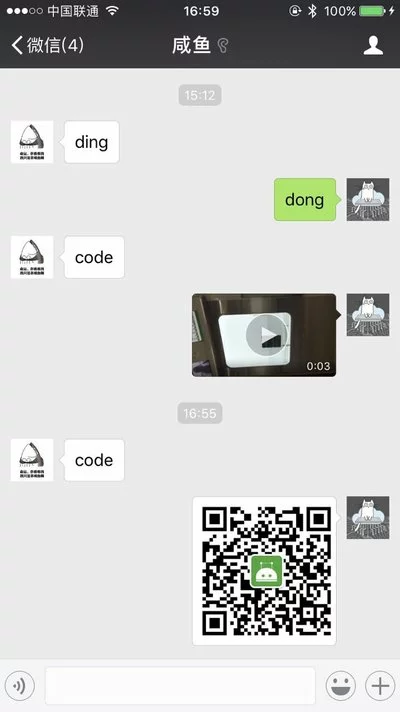Wechaty解决了很多我在使用微信运营过程中的痛点问题,这里就不再一一赘述了。同时Wechaty的API设计简洁优雅,部署方便也是另外一个吸引我的地方。
快速上手后,在开发调试过程中,修改代码需要频繁重启Wechaty程序。相信绝大多数人都有着类似的问题, 下面就聊一聊怎么避免类似问题。
1. 问题分析
在开发调试过程中,修改代码后必须重启Wechaty程序。每次重启大概会花上30s-60s左右。还需要开发者频繁扫码登陆,对于在调试阶段的程序来说,成本还是很高的。因此考虑从这里入手看能否优化这里的启动时间。
对于扫码登陆的问题,从Wiki中找到答案:
Wechaty.instance(profile:string): Wechaty
profile(OPTIONAL): profile name. if a profile name is provided, wechaty will save login status to it, and automatically restored on next time of wechaty start(restart).
- can be set by environment variable: WECHATY_PROFILE
也就是说设置一个profile就可以记住登录态,避免重启时的重复扫码动作。 扫码问题可以得到解决,那么30-60s的启动时间是否还可以进一步优化呢?那就得弄清楚这30s的时间里,程序都在做什么。
通过查看源代码 browser-driver.ts 发现,在执行init时,程序会启动一个driver,可以看作是打开了一个浏览器,然后获取浏览器 session,重复尝试三次直到失败。这里是Wechaty运行的基础,我们没有办法从这里去避免这30s的时间开销。只能从另外的方面去思考。
2. Node.js 热重启
这里实际就是Node.js本身的特性了,与Wechaty本身关联不大。可能通过监听文件改动从而动态加载模块内容,这里首先就要了解Node.js的模块缓存机制,参看module.js关键代码:
// Check the cache for the requested file.
// 1. If a module already exists in the cache: return its exports object.
// 2. If the module is native: call `NativeModule.require()` with the
// filename and return the result.
// 3. Otherwise, create a new module for the file and save it to the cache.
// Then have it load the file contents before returning its exports
// object.
Module._load = function(request, parent, isMain) {
if (parent) {
debug('Module._load REQUEST %s parent: %s', request, parent.id);
}
var filename = Module._resolveFilename(request, parent, isMain);
var cachedModule = Module._cache[filename];
if (cachedModule) {
return cachedModule.exports;
}
if (NativeModule.nonInternalExists(filename)) {
debug('load native module %s', request);
return NativeModule.require(filename);
}
var module = new Module(filename, parent);
if (isMain) {
process.mainModule = module;
module.id = '.';
}
Module._cache[filename] = module;
tryModuleLoad(module, filename);
return module.exports;
};
require.cache = Module._cache;
如果Node.js已经require某个模块后,模块更新后,再次require这个模块时,实际读取的是内存中的原模块的缓存。除非手动清除掉require.cache的内容,这样才能重新加载更新后的模块内容。因此参照Node.js源码写出require缓存清除方法:
// purge require cache
const purgeCache = (moduleName) => {
var mod = require.resolve(moduleName);
if (mod && ((mod = require.cache[mod]) !== undefined)) {
(function traverse(mod) {
mod.children.forEach(function (child) {
traverse(child);
});
delete require.cache[mod.id];
}(mod));
}
Object.keys(module.constructor._pathCache).forEach(function(cacheKey) {
if (cacheKey.indexOf(moduleName)>0) {
delete module.constructor._pathCache[cacheKey];
}
});
};
再利用fs.watch或者chokidar之类的库完成文件监听功能,实现文件改动后重新加载模块:
fs.watch('./somedir', (e, filename) => {
purgeCache(`./somedir/${filename}`);
require(`./somedir/${filename}`);
});
3. 逻辑抽离
在使用Wechaty的时候,开发者更多的是关心事件响应,比如响应扫码事件、好友请求事件、发送消息事件等等。因此可以单独将这些响应事件抽离出来。如果我需要关注好友请求事件,那么我就添加一个friend.js去处理。如果我需要关注发消息事件,那么就去添加一个message.js去处理。相反,不需要了我删除掉该js文件即可。每一个文件就是一个事件处理器。代码如下:
const EVENT_LIST = ['scan', 'logout', 'login', 'friend', 'room-join', 'room-leave', 'room-topic', 'message', 'heartbeat', 'error'];
let eventHandler = {};
// Load lisenter
const loadListener = (evt) => {
let fn;
try {
fn = require(`./listener/${evt}`);
console.log(`binded listener: ${evt}`);
} catch (e) {
fn = () => void 0;
if (e.toString().indexOf('Cannot find module') > -1) {
console.warn(`listener ${evt} is not defined.`);
} else {
console.error(e);
}
}
return fn;
}
// Bind events
EVENT_LIST.forEach(evt => {
eventHandler[evt] = loadListener(evt);
bot.on(evt, eventHandler[evt]);
});
4. 整合
接着就是整合逻辑代码与热重启功能,让每个事件处理器都具有热重启功能。
fs.watch('./listener', (e, filename) => {
let evt = filename.substring(0, filename.length - 3);
console.log(`${e}: ${filename}`);
if (EVENT_LIST.indexOf(evt) > -1) {
if (e === 'change') {
console.log(`${evt} listener reloaded.`);
purgeCache(`./listener/${evt}`);
// It may read an empty file, if not use setTimeout
setTimeout(() => {
bot.removeListener(evt, eventHandler[evt]);
//console.log('filecontent: ' + fs.readFileSync(`./listener/${evt}.js`));
eventHandler[evt] = loadListener(evt);
bot.on(evt, eventHandler[evt]);
}, 1000);
} else if (e === 'rename') {
console.log(`${evt} listener removed.`);
bot.removeListener(evt, eventHandler[evt]);
eventHandler[evt] = () => void 0;
bot.on(evt, eventHandler[evt]);
}
}
});
检测到./listener目录下的文件改动后,自动删除原来事件监听并且更新,这样就完美的实现了Wechaty免重启开发调试了。
最后,还需要一个环境变量来区分开发模式和线上模式,在线上模式中就不需要使用热重启功能。
const isProd = process.env.NODE_ENV === 'production';
if (isProd) {
fs.watch('./listener', ....);
}
这样就可以通过以下命令来进入开发模式或者线上模式了。
// development
docker run -ti --rm --volume="$(pwd)":/bot zixia/wechaty index.js
// production
docker run -ti -e NODE_ENV=production --rm --volume="$(pwd)":/bot zixia/wechaty index.js
附热重启机器人效果图:

到这里就基本介绍完了本篇文章的全部内容了,可以使用example代码来体验。
作者:@Gcaufy, Tencent, Wechaty Contributor
